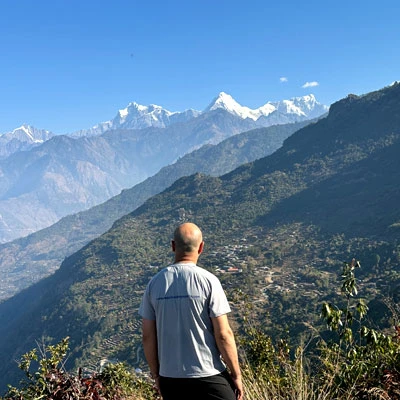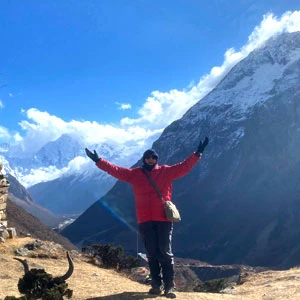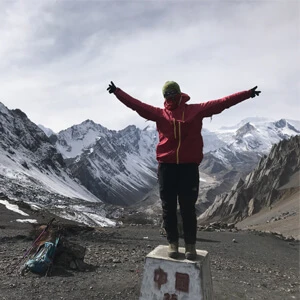Factors That Influence The Difficulty Of The Gokyo Valley Trek
There are several key factors, such as high altitude, rugged trails, unpredictable weather, and daily trekking hours, that directly influence the difficulty of this trek. Hence, proper preparation and awareness of these factors are crucial.
Altitude Level
This particular trek reaches its highest point at Gokyo Ri (5,357 meters / 17,575 feet), where you will experience high-altitude conditions. Likewise, you will spend most of your days above 2,500 meters.
At these elevations, the air contains less oxygen, making it harder to breathe and increasing the strain on your cardiovascular system. As a result, the risk of Acute Mountain Sickness (AMS) becomes a serious concern.
Here, AMS can affect anyone, regardless of fitness level. The symptoms often begin with headaches, dizziness, nausea, vomiting, loss of appetite, and fatigue. If you do not address them, they can worsen, potentially leading to more severe complications such as high-altitude cerebral edema (HACE) or high-altitude pulmonary edema (HAPE).
Tips To Manage Altitude
- Follow the “climb high, sleep low” strategy. Ascend during the day and return to a lower altitude to sleep.
- Stay well-hydrated, as dehydration can worsen altitude sickness.
- Eat balanced meals with high energy to help maintain strength and stamina.
- Watch out for the common symptoms of the AMS. Stop ascending immediately if you have altitude sickness.
- Pay attention to any signs of discomfort or fatigue in your body and take breaks as needed.
Duration And Daily Walking Hours
Typically, the trek to Gokyo Valley spans 11 to 14 days, depending on the itinerary and your pace. On average, you will spend 5 to 7 hours walking each day, covering distances between 10 to 15 kilometers on rugged, sometimes steep terrain.
At times, these long days of trekking can be physically challenging, particularly as the altitude increases and the air thins.
Tips To Reduce Fatigue From Long Walking Hours
- Ensure your itinerary includes rest days for recovery, especially at higher altitudes.
- Use acclimatization hikes during rest days to help your body adjust to the higher elevations without overexerting yourself.
- Avoid rushing through the trek. Pace yourself by taking breaks and adjusting your speed according to how your body feels.
- Stick to the scheduled breaks, even if your body feels like it can keep going. Take this break to hydrate, rest, and snack to keep up your energy level.
Trail Conditions
The route to Gokyo valley consists of a mix of rocky paths, steep ascents and descents, and glacier crossings. One of the most significant challenges you will face on the way is crossing the Ngozumpa Glacier, Nepal’s longest glacier.
This glacier section is often uneven and covered with loose rocks, ice, and snow, making it difficult to navigate. You must have careful attention to footing and pacing. In addition, the trail involves a combination of rugged terrain, narrow paths along cliffs, and steep inclines, which can be physically taxing, especially as you gain altitude.
Here, the constant shifts in elevation bring sections that require you to climb steep ascents and descend equally steep slopes. These transitions can be tough on the knees and lungs. Likewise, in certain seasons, snow and ice accumulation might make the paths more challenging.
Tips To Manage Difficult Trails
- Carry trekking poles to improve balance, reduce pressure on your knees, and stabilize yourself on rocky or icy terrain.
- Place each step deliberately, especially when crossing loose rocks, glacier surfaces, and steep ascents or descents.
- Always follow the guide’s lead while navigating a difficult section.
- Slow down on tricky sections like steep climbs, rocky trails, and glacier crossings.
Weather And Temperature
Throughout the year, the weather patterns shift dramatically. Spring (March to May) and Autumn (September to November) are the best time to trek to Gokyo Valley, as they offer stable weather, clear skies, and comfortable daytime temperatures. However, even during these peak seasons, you may face cold nights and early morning climbs, especially at higher elevations.
In contrast, Winter (December to February) brings harsh cold, heavy snowfall, and increased risk of trail closures, which makes the trek considerably more challenging. On the other hand, the Monsoon season (June to August) covers the trails with rain, creating slippery paths. Likewise, the frequent cloud cover also hides mountain views and increases trekking difficulty.
At higher elevations, particularly above 4,000 meters, the impact of cold temperatures becomes even more pronounced. Even on sunny days, the wind chill can be biting, and nighttime temperatures can plunge well below zero.
Tips To Manage Weather And Temperature Challenges
- Use the layering system (base layer, insulating layer, and outer shell) to adjust your clothing as temperatures change throughout the day.
- Invest in high-quality, durable, and water-resistant gear for the trek.
- Begin your hike soon after sunrise to take advantage of relatively warmer and more stable morning weather.
- Stay informed about upcoming weather patterns through your guide.
- Make your itinerary flexible in case of an unexpected change in weather.
Physical Fitness Level
To trek within the Gokyo Valley, you will need to be in good physical shape. Since each day involves walking 5 to 7 hours across varying terrain, you will need to have more energy.
As a trekker, you must have strong cardiovascular endurance, leg strength, and core stability. Here, your poor fitness can lead to slower pacing, increased risk of injury, and a greater struggle with altitude.
Tips To Build Physical Fitness
- Begin your fitness preparation at least 2 to 3 months before your trek to build endurance gradually and safely.
- For cardiovascular endurance, you can engage in activities like running, cycling, swimming, and brisk walking.
- Do exercises like lunges, squats, step-ups, and calf raises to prepare your legs for steep ascents and descents.
- Add planks, bridges, and abdominal exercises to your routine to improve balance and reduce the risk of injuries on uneven trails.
- Include stretching sessions or yoga to improve flexibility and reduce muscle soreness.
- Balance training with proper rest days to avoid burnout or injury before the trek begins.
Difficulty Difference On Trekking Independently Vs. With A Guide
Trekking independently and hiring a guide for the Gokyo Valley Trek is a two different worlds. If you are trekking solo, you take full responsibility for navigation, logistics, and safety, which can make the trek far more challenging, especially in remote areas with limited trail markers.
Finding the correct path across sections like the Ngozumpa Glacier demands strong route-finding skills. So, as a solo trekker, you will be confused and defeated in the process.
Apart from it, if you are trekking solo, you will also face logistical hurdles like arranging permits, booking lodges during peak seasons, and managing daily schedules without local support. Additionally, communication challenges add another layer of difficulty.
Along the trek, you will find that English is not always spoken fluently in the more remote villages of Gokyo Valley. Hence, traveling alone might prove to be a nightmare as you may not get reliable information or help when needed. Lastly, without professional backup, you must also independently monitor your health for signs of altitude sickness or other medical concerns.
On the other hand, if you are trekking with a professional guide, you will not have a single worry on yourself. The guide will handle navigation, plan safe acclimatization schedules, communicate with locals, and swiftly organize help during emergencies.
They also enrich your journey with insights into local culture, traditions, and landscapes you might otherwise miss.
Who Can Do The Gokyo Valley Trek?
The Gokyo Valley Trek welcomes a wide range of adventurers, but a few key factors can determine who will enjoy it most. Ideally, Nepal Trekking Experts recommend this trek if you have prior high-altitude experience, as you will already be familiar with the challenges of thinner air and rugged terrain.
However, even if you are a first-time trekker with strong physical preparation and a determined mindset, you can absolutely take on this journey successfully. In terms of age, the trek suits young adults to senior trekkers who are in good health and capable of walking long hours each day.
Conclusion
The Gokyo Valley Trek is a strenuous adventure that demands physical fitness, mental resilience, and proper planning. Factors like high altitude, long walking hours, rugged trail conditions, unpredictable weather, and the need for careful navigation all add layers of difficulty to the journey. However, with the right preparation and a solid understanding of the trail, the challenges become manageable and even part of the rewarding experience.
To make your trek safe, smooth, and truly rewarding, contact Nepal Trekking Experts, who specialize in creating memorable journeys with personalized care.
FAQs
How difficult is the Gokyo Valley Trek?
The Gokyo Valley Trek is considered strenuous, mainly due to high altitude, long walking days, and rugged trails.
Do I need previous trekking experience to complete the Gokyo Valley Trek?
No, not necessarily. But prior high-altitude trekking experience is helpful, however, first-time trekkers with good preparation can also complete it.
What is the highest point of the Gokyo Valley Trek?
The highest point is Gokyo Ri, which stands at 5,357 meters (17,575 feet).
How long does the Gokyo Valley Trek take?
This trek typically takes 11 to 14 days, depending on your pace and acclimatization schedule.
How many hours will I walk each day during the Gokyo Valley Trek?
You should expect to trek around 5 to 7 hours daily, with some days slightly longer during ascents or glacier crossings.
Is altitude sickness a risk during the trek?
Yes, altitude sickness is a risk, hence, proper acclimatization and slow ascent are crucial to stay safe.
Can beginners do the Gokyo Valley Trek?
Yes, beginners with good fitness, strong mental preparation, and a guided itinerary can successfully complete it.
When is the best time to do the Gokyo Valley Trek?
Spring (March to May) and Autumn (September to November) are the best times for this trek as it offers the best weather, clearer skies, and safer trails.
How cold does it get during the trek?
Temperatures can drop below freezing, especially at night and during early morning climbs at higher elevations.
What physical training should I do before the trek?
Focus on cardio, strength training, and endurance exercises at least 2 to 3 months before your trek.
Can senior trekkers do the Gokyo Valley Trek?
Yes, as long as they are in good health, physically fit, and follow a gradual pace with proper acclimatization.







